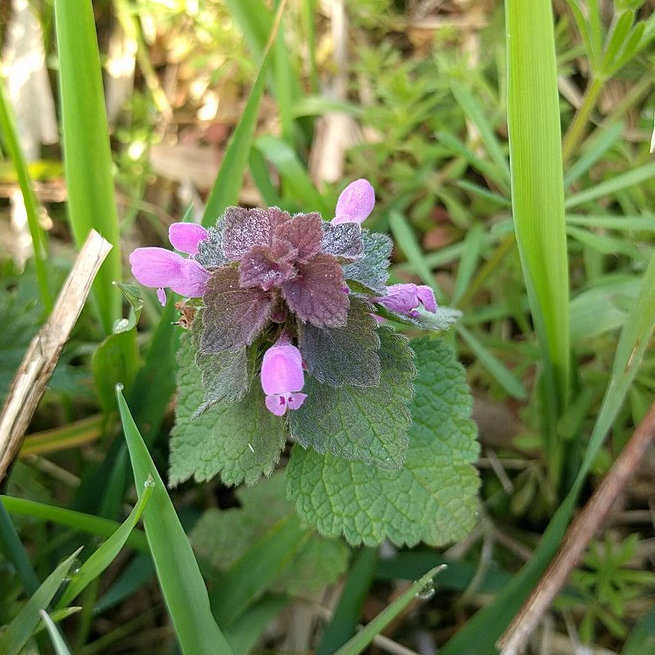- Home
- Wild Plants
- Wildflowers
- Shade plants
- Red deadnettle
Red deadnettle Lamium purpureum
Family – Lamiaceae, mint family
Small annual up to 25 cm tall, c20cm spread
Flowering – spring to autumn
Soils - any well-drained soil
Position – Full sun or partial shade
This is an overwintering annual, with a short branching stem, nearly round purplish leaves and small reddish-purple flowers. Unlike white deadnettle it could not be confused with stinging nettle. It (like all our Lamium) is considered an archaeophyte, that arrived in Britain with human help before 1500, and another name for it is French nettle. It was first recorded by Turner in 15481. .
It is common throughout Britain and Ireland on waste ground and in cultivated areas2. , and is easy to grow in open situations. Vickery records a number of local names, including bad-man's posy, bee nettle and bumblebee flower - names noting its popularity with bumblebees.
Red deadnettle is a foodplant for about 12 moths, including the muslin moth Diaphora mendica and the plain golden Y moth Autographa jota4. .
This should not be confused with spotted deadnettle L. maculatum, a pink or red-flowered species introduced from elsewhere in western Europe and common in gardens. L. maculatum is a spreading perennial, with leaves that are larger and more diamond-shaped than those of L. purpureum and often blotched or completely coloured silver5. .
Spotted deadnettle Lamium maculatum
References
1. Pearman, D. (2017). The Discovery of the Native Flora of Britain and Ireland, Botanical Society of Britain & Ireland. P. 250
2. Stace, C. 2010 New Flora of the British Isles, Third Edition. P. 618.
3. Vickery, R. 2019. Vickery’s Folk Flora, An A to Z of the Folklore and Uses of British and Irish Plants. P. 566
4. See the Biological Record Centre database
5. RHS website description of L. maculatum accessed 5 April 2023.
Page written by Marc Carlton. Compiled by Steve Head



Red deadnettle Lamium purpureum
Small annual up to 25 cm tall, c20cm spread
Flowering – spring to autumn
Soils - any well-drained soil
Position – Full sun or partial shade


This is an overwintering annual, with a short branching stem, nearly round purplish leaves and small reddish-purple flowers. Unlike white deadnettle it could not be confused with stinging nettle. It (like all our Lamium) is considered an archaeophyte, that arrived in Britain with human help before 1500, and another name for it is French nettle. It was first recorded by Turner in 15481. .
It is common throughout Britain and Ireland on waste ground and in cultivated areas2. , and is easy to grow in open situations. Vickery records a number of local names, including bad-man's posy, bee nettle and bumblebee flower - names noting its popularity with bumblebees.
Red deadnettle is a foodplant for about 12 moths, including the muslin moth Diaphora mendica and the plain golden Y moth Autographa jota4. .
This should not be confused with spotted deadnettle L. maculatum, a pink or red-flowered species introduced from elsewhere in western Europe and common in gardens. L. maculatum is a spreading perennial, with leaves that are larger and more diamond-shaped than those of L. purpureum and often blotched or completely coloured silver5. .

Spotted deadnettle Lamium maculatum
References
1. Pearman, D. (2017). The Discovery of the Native Flora of Britain and Ireland, Botanical Society of Britain & Ireland. P. 250
2. Stace, C. 2010 New Flora of the British Isles, Third Edition. P. 618.
3. Vickery, R. 2019. Vickery’s Folk Flora, An A to Z of the Folklore and Uses of British and Irish Plants. P. 566
4. See the Biological Record Centre database
Page written by Marc Carlton. Compiled by Steve Head






